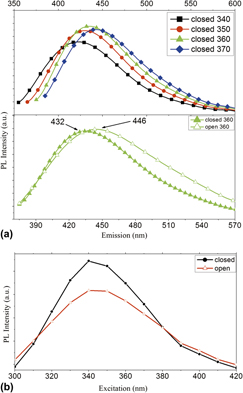Crossref Citations
This article has been cited by the following publications. This list is generated based on data provided by
Crossref.
Mwania, Munuve
Janáky, Csaba
Rajeshwar, Krishnan
and
Kroll, Peter
2013.
Fabrication of β-SiC quantum dots by photo-assisted electrochemical corrosion of bulk powders.
Electrochemistry Communications,
Vol. 37,
Issue. ,
p.
1.
Fan, Ji-Yang
and
Chu, Paul Kim-Ho
2014.
Silicon Carbide Nanostructures.
p.
131.
Song, Yuepeng
Gao, Dongsheng
Kim, Hyoung Seop
Qu, Cuiqin
Kang, Jie
Zhu, Yanmin
Liu, Ziping
Guo, Jing
Xu, Lingfeng
and
Lee, Chong Soo
2014.
Fabrication of Silicon Carbide Quantum Dots via Chemical-Etching Approach and Fluorescent Imaging for Living Cells.
Materials Sciences and Applications,
Vol. 05,
Issue. 04,
p.
177.
Castelletto, Stefania
Johnson, Brett C.
Zachreson, Cameron
Beke, David
Balogh, István
Ohshima, Takeshi
Aharonovich, Igor
and
Gali, Adam
2014.
Room Temperature Quantum Emission from Cubic Silicon Carbide Nanoparticles.
ACS Nano,
Vol. 8,
Issue. 8,
p.
7938.
Szekrényes, Zsolt
Somogyi, Bálint
Beke, Dávid
Károlyházy, Gyula
Balogh, István
Kamarás, Katalin
and
Gali, Adam
2014.
Chemical Transformation of Carboxyl Groups on the Surface of Silicon Carbide Quantum Dots.
The Journal of Physical Chemistry C,
Vol. 118,
Issue. 34,
p.
19995.
Jokubavicius, Valdas
Yazdi, G. Reza
Liljedahl, Rickard
Ivanov, Ivan G.
Yakimova, Rositsa
and
Syväjärvi, Mikael
2014.
Lateral Enlargement Growth Mechanism of 3C-SiC on Off-Oriented 4H-SiC Substrates.
Crystal Growth & Design,
Vol. 14,
Issue. 12,
p.
6514.
Muzha, A.
Fuchs, F.
Tarakina, N. V.
Simin, D.
Trupke, M.
Soltamov, V. A.
Mokhov, E. N.
Baranov, P. G.
Dyakonov, V.
Krueger, A.
and
Astakhov, G. V.
2014.
Room-temperature near-infrared silicon carbide nanocrystalline emitters based on optically aligned spin defects.
Applied Physics Letters,
Vol. 105,
Issue. 24,
Chaukulkar, Rohan P
de Peuter, Koen
Ghodes, Jacob A
Pylypenko, Svitlana
Cloud, Jacqueline E
Yang, Yongan
Stradins, Paul
and
Agarwal, Sumit
2015.
Single-step non-thermal plasma synthesis of 3C-SiC nanoparticles.
Materials Research Express,
Vol. 2,
Issue. 1,
p.
015019.
Wu, Renbing
Zhou, Kun
Yue, Chee Yoon
Wei, Jun
and
Pan, Yi
2015.
Recent progress in synthesis, properties and potential applications of SiC nanomaterials.
Progress in Materials Science,
Vol. 72,
Issue. ,
p.
1.
Alekseev, Sergei
Korytko, Dmytro
Iazykov, Maksym
Khainakov, Sergei
and
Lysenko, Vladimir
2015.
Electrochemical Synthesis of Carbon Fluorooxide Nanoparticles from 3C-SiC Substrates.
The Journal of Physical Chemistry C,
Vol. 119,
Issue. 35,
p.
20503.
Beke, David
Szekrényes, Zsolt
Czigány, Zsolt
Kamarás, Katalin
and
Gali, Ádám
2015.
Dominant luminescence is not due to quantum confinement in molecular-sized silicon carbide nanocrystals.
Nanoscale,
Vol. 7,
Issue. 25,
p.
10982.
Rashid, Marzaini
Tiwari, Amit K.
Goss, J. P.
Rayson, M. J.
Briddon, P. R.
and
Horsfall, A. B.
2016.
Surface-state dependent optical properties of OH-, F-, and H-terminated 4H-SiC quantum dots.
Physical Chemistry Chemical Physics,
Vol. 18,
Issue. 31,
p.
21676.
Beke, David
Jánosi, Tibor Z
Somogyi, Bálint
Major, Dániel Á.
Szekrényes, Zsolt
Erostyák, János
Kamarás, Katalin
and
Gali, Adam
2016.
Identification of Luminescence Centers in Molecular-Sized Silicon Carbide Nanocrystals.
The Journal of Physical Chemistry C,
Vol. 120,
Issue. 1,
p.
685.
Rashid, Marzaini
Horrocks, B. R.
Healy, N.
Goss, J. P.
and
Horsfall, A. B.
2016.
Optical properties of mesoporous 4H-SiC prepared by anodic electrochemical etching.
Journal of Applied Physics,
Vol. 120,
Issue. 19,
Dravecz, Gabriella
Bencs, László
Beke, Dávid
and
Gali, Adam
2016.
Determination of silicon and aluminum in silicon carbide nanocrystals by high-resolution continuum source graphite furnace atomic absorption spectrometry.
Talanta,
Vol. 147,
Issue. ,
p.
271.
Beke, David
Horváth, Klaudia
Kamarás, Katalin
and
Gali, Adam
2017.
Surface-Mediated Energy Transfer and Subsequent Photocatalytic Behavior in Silicon Carbide Colloid Solutions.
Langmuir,
Vol. 33,
Issue. 50,
p.
14263.
Castelletto, S.
Almutairi, A. F. M.
Thalassinos, G.
Lohrmann, A.
Buividas, R.
Lau, D. W. M.
Reineck, P.
Juodkazis, S.
Ohshima, T.
Gibson, B. C.
and
Johnson, B. C.
2017.
Fluorescent color centers in laser ablated 4H-SiC nanoparticles.
Optics Letters,
Vol. 42,
Issue. 7,
p.
1297.
Beke, David
Károlyházy, Gyula
Czigány, Zsolt
Bortel, Gábor
Kamarás, Katalin
and
Gali, Adam
2017.
Harnessing no-photon exciton generation chemistry to engineer semiconductor nanostructures.
Scientific Reports,
Vol. 7,
Issue. 1,
Wang, Zhan
Yang, Wen
and
Wang, Yong
2017.
Self-Trapped Exciton and Large Stokes Shift in Pristine and Carbon-Coated Silicon Carbide Quantum Dots.
The Journal of Physical Chemistry C,
Vol. 121,
Issue. 36,
p.
20031.
Alekseev, Sergei
Shamatulskaya, Elena
Volvach, Mykola
Gryn, Svitlana
Korytko, Dmytro
Bezverkhyy, Igor
Iablokov, Viacheslav
and
Lysenko, Vladimir
2017.
Size and Surface Chemistry Tuning of Silicon Carbide Nanoparticles.
Langmuir,
Vol. 33,
Issue. 47,
p.
13561.



